Correlation/ Regression
1/52
There's no tags or description
Looks like no tags are added yet.
Name | Mastery | Learn | Test | Matching | Spaced |
|---|
No study sessions yet.
53 Terms
Putting Correlation / Regression into Context
DV = interval/ratio
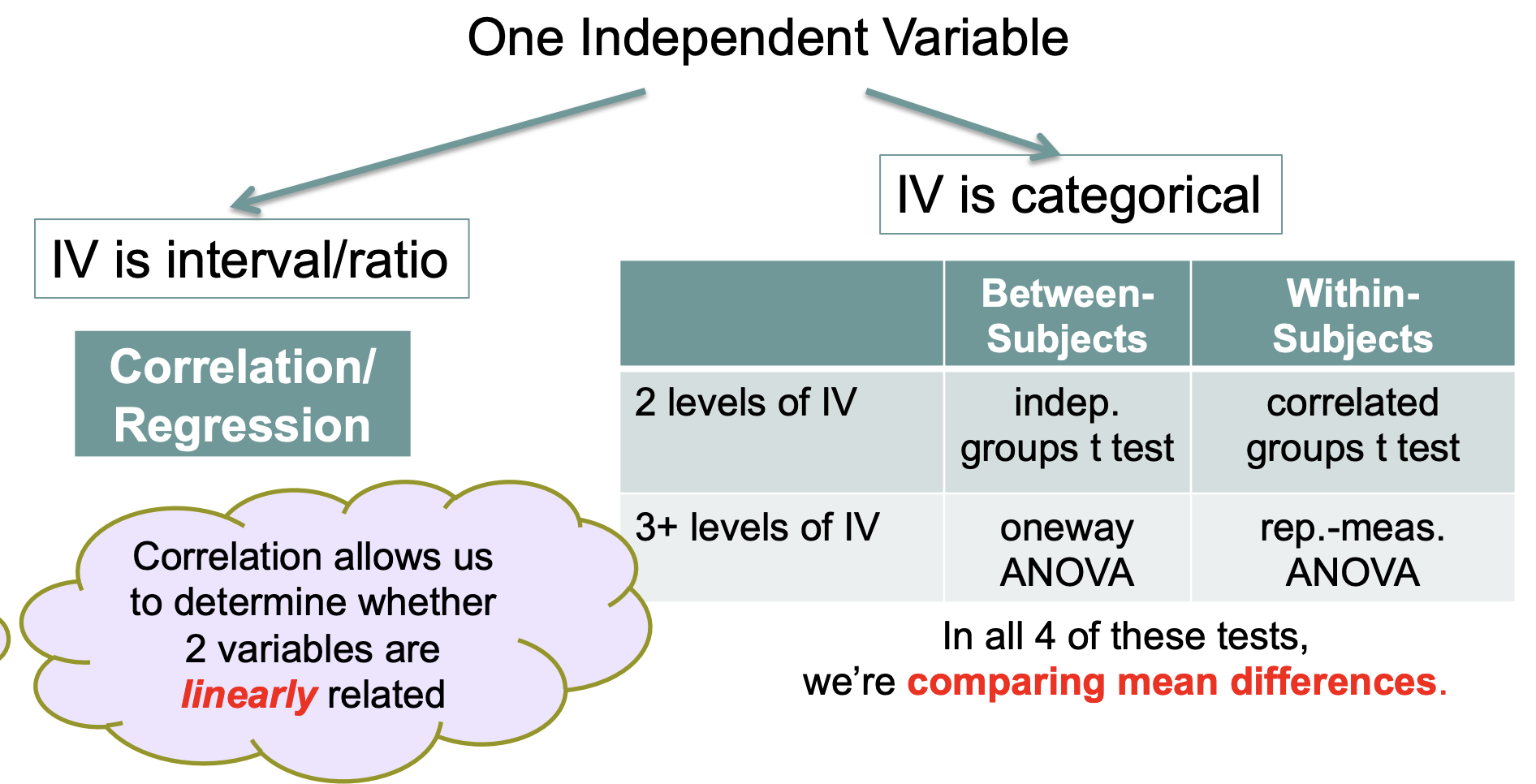
Three Characteristics of a Correlation (r) Between X & Y
Direction: positive, negative, no correlation
Degree / magnitude: ranges from -1 to +1; extreme scores unlikely
Possible ranges of r values [-1 to +1] perfect negative correlation to perfect positive correlation… correlations closer to -1 or +1 = points are closer to the regression line… unlikely to get a correlation of ±1 because… measurement error, Y is predicted by more than just 1 X variable
Form: correlation useful only for linear relationships
![<p><strong>Direction</strong>: positive, negative, no correlation</p><p><strong>Degree / magnitude</strong>: ranges from -1 to +1; extreme scores unlikely</p><ul><li><p>Possible ranges of r values [-1 to +1] perfect negative correlation to perfect positive correlation… correlations closer to -1 or +1 = <u>points are closer to the regression line</u>… unlikely to get a correlation of <span>±1 because… <em>measurement error, Y is predicted by more than just 1 X variable </em></span><em> </em></p></li></ul><p><strong>Form</strong>: correlation useful only for <em>linear</em> relationships </p><p></p>](https://knowt-user-attachments.s3.amazonaws.com/61f7c5af-86de-4abc-8392-7e520994795b.png)
Important note
Before conducting statistical analyses (e.g., calculating r), always look at your x and y data by producing a scatterplot!
Problems to Watch Out For: Restricted Range
Occurs when experimenters look at only one portion of the data (not good)
Can lead to underestimation of a relationship between X and Y
Can lead to overestimation of a relationship between X and Y
Restricted Range: Case 1
Underestimation of association
Strong linear relationship when full range of x values is used, but no relationship when restricted range used
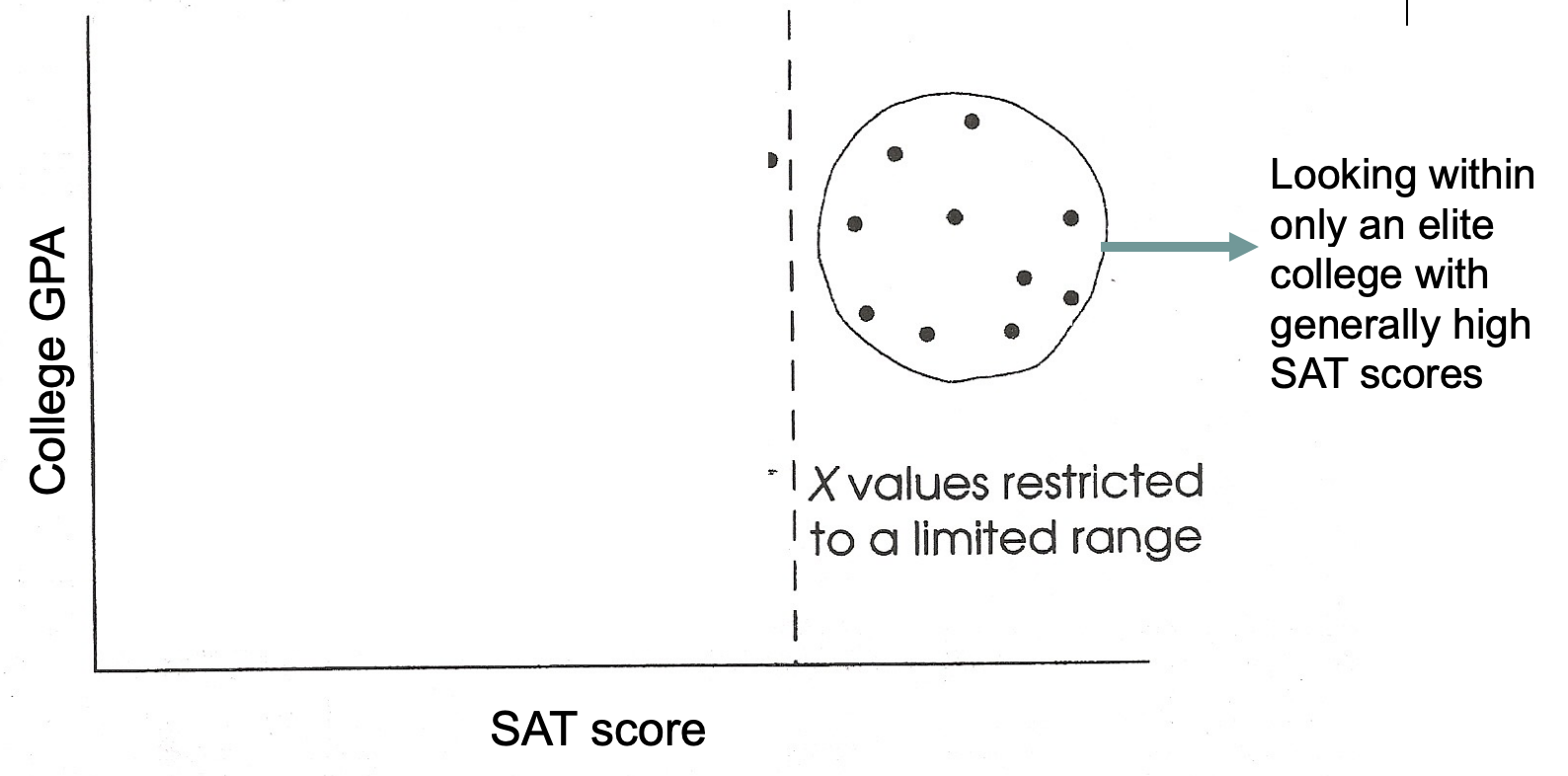
Restricted Range: Case 2
Underestimation of association
Strong linear relationship when full range of x values is used, but no relationship when restricted range used
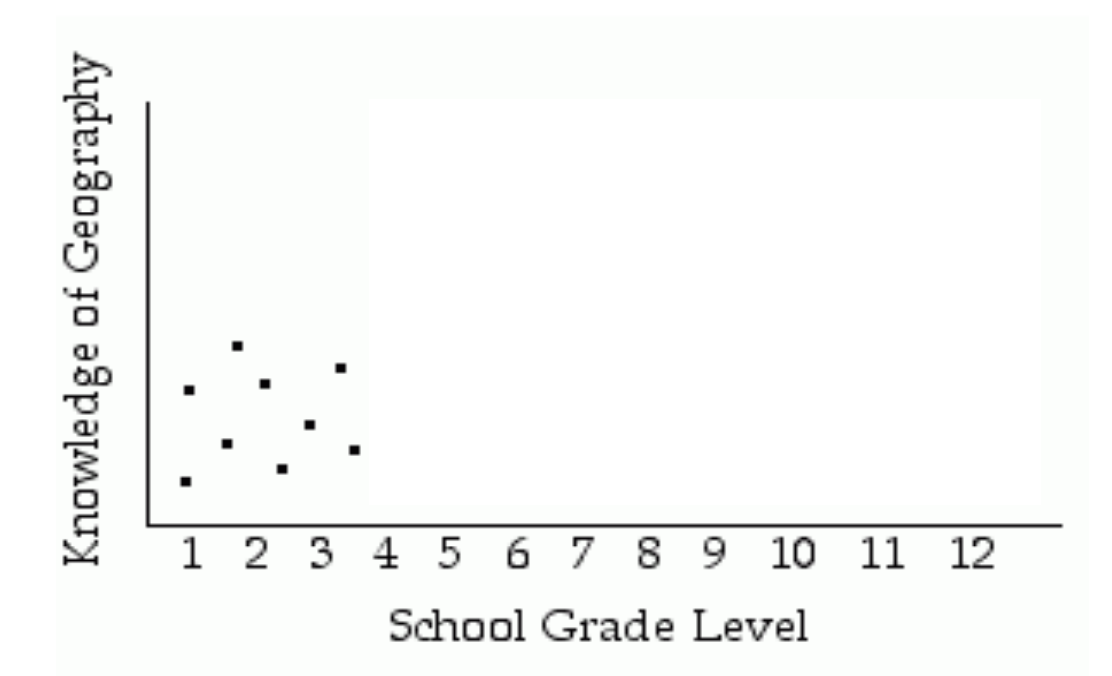
Restricted Range: Case 3
Overestimation of association
No relationship when full range of x values is used, but strong relationship when restricted range used
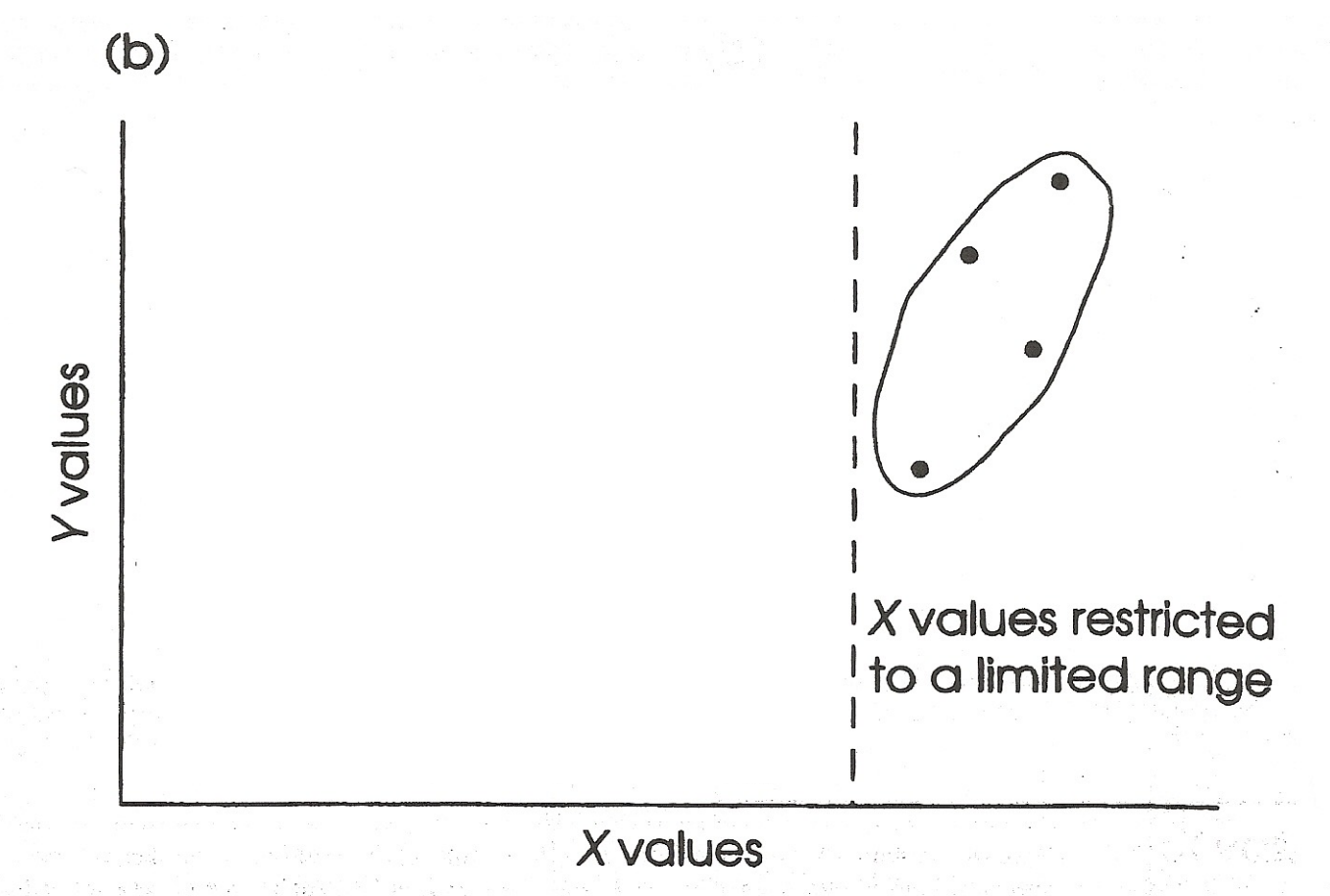
Non-linear relationships: Example 1
Curvilinear relationship:
If we looked only at low to moderate levels of anxiety, we would come to an erroneous conclusion about the relationship between anxiety and performance.
To be safe, use a wide range of X and Y values, and do not make conclusions based on extrapolation beyond your observed values of X
SIDE NOTE: I will ask you to extrapolate when you calculate the regression line, though.
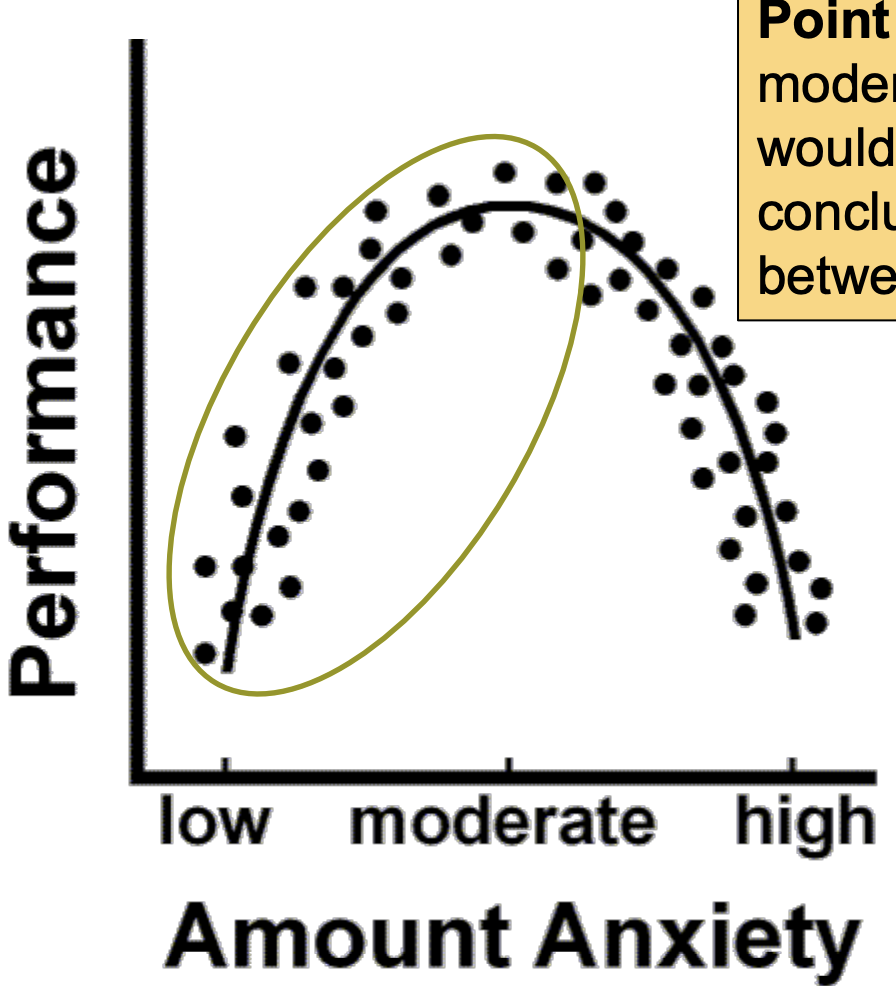
Non-linear relationships: Example 2
These data are not linear (the curve levels off – is asymptotic)
Here, the change in the y-values become increasingly small as the x-values increase.
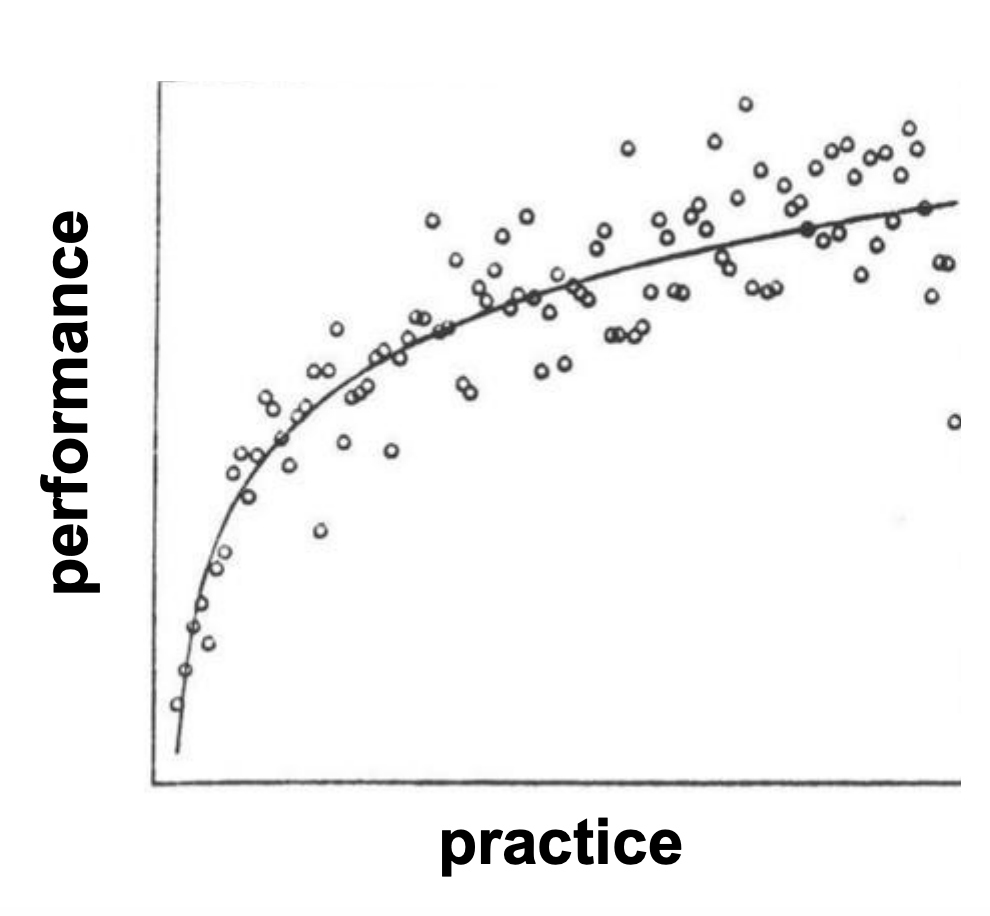
Problems to watch out for: Outliers
Scores that are outside the range for X, Y, or both
Can cause either over or underestimation of the correlation
Outliers: Overestimation of association
Including the outlier (inaccurately) strengthens the correlation.
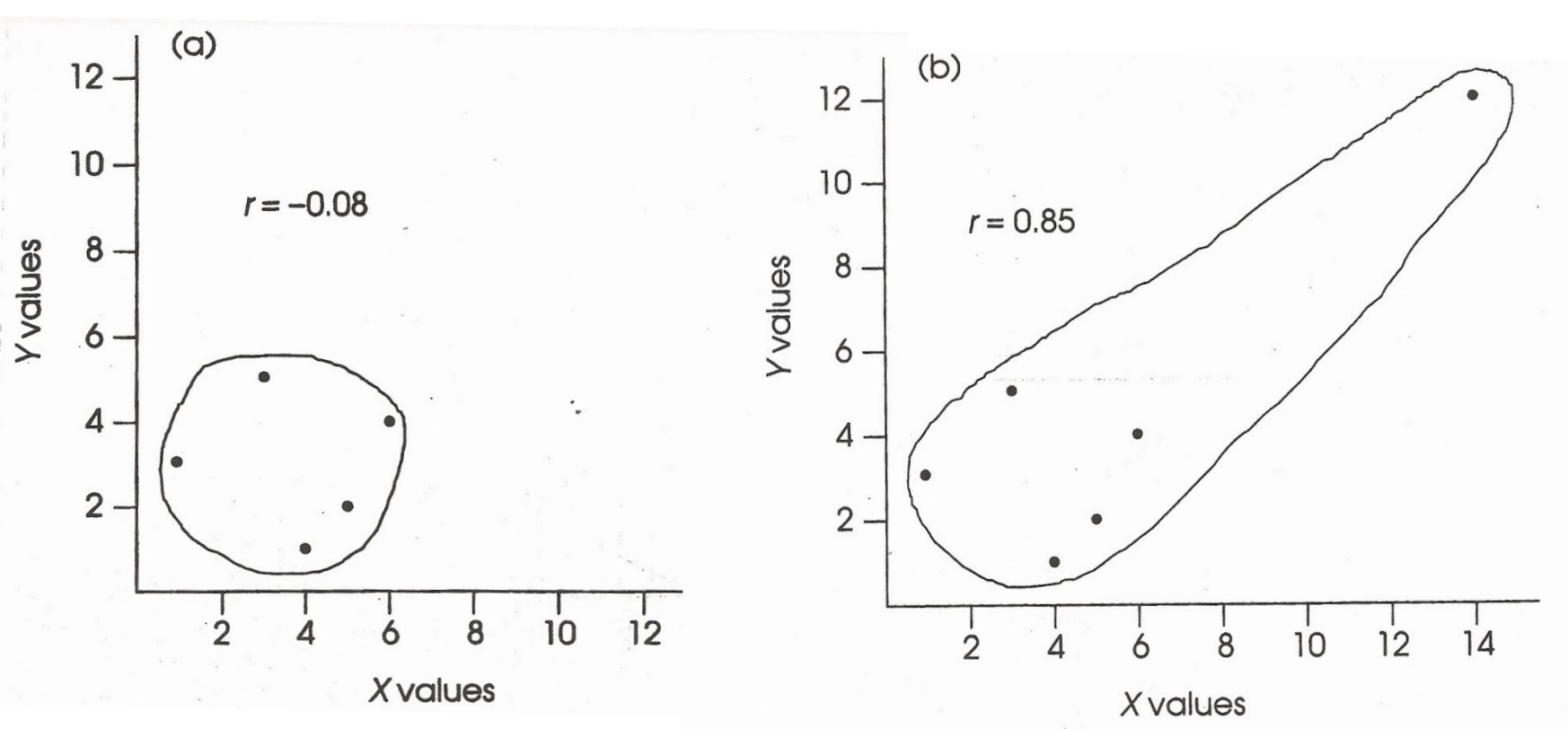
Outliers: Underestimation of association
In this case, including the outlier weakens the correlation
Bottom line: set criteria for outlier removal BEFORE plotting/ analyzing the data; do not tempt yourself into selective data trimming!
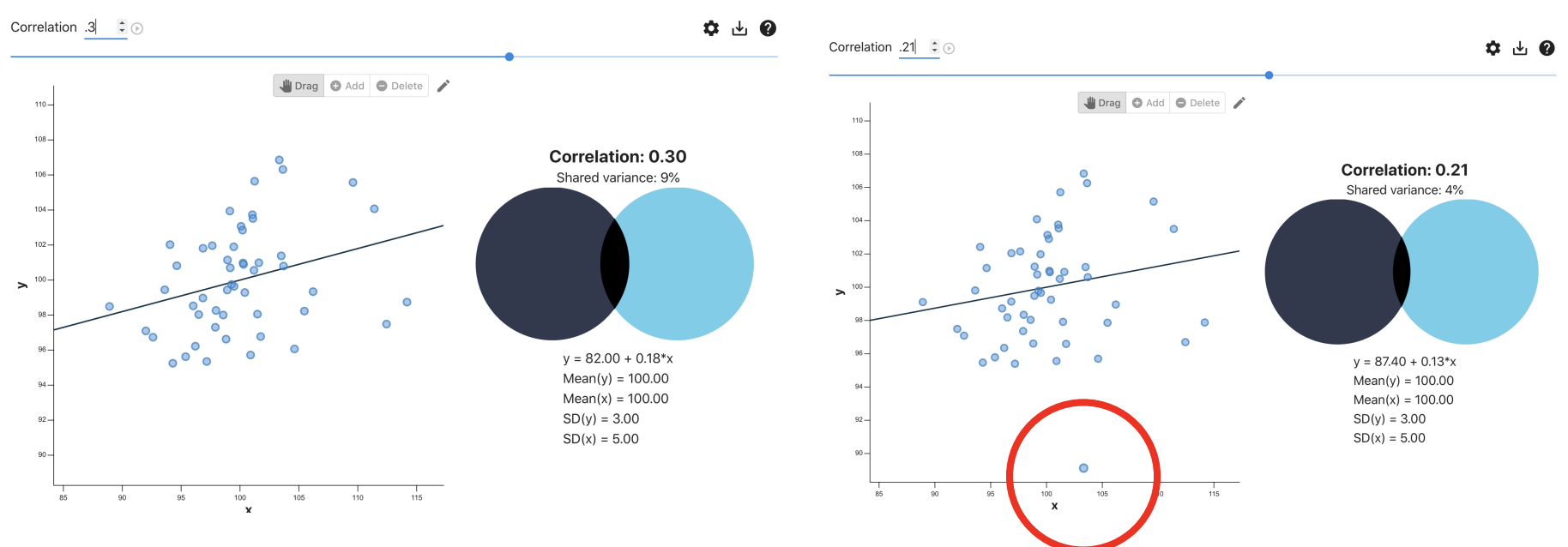
The Pearson Product-Moment Correlation (r) - Conceptual Understanding
r is an indicator of location in X distribution (relative to mean of X)
& location in Y distribution (relative to mean of Y)
Regression line must cross through the mean of & the mean of Y
We can use z scores to precisely describe the location of an individual within a distribution.
For a positive correlation: positive Z scores on X correspond to positive Z scores on Y; negative Z scores on X correspond to negative Z scores on Y.
For a negative correlation, positive Z scores on X correspond to negative Z scores on Y and vice-versa.
We cannot just use ∑ZXZY as a measure of r because of the same drawback we ran into with the SS…
It keeps getting larger and larger as the number of scores increases. But.. Use same solution (divide by N-1)
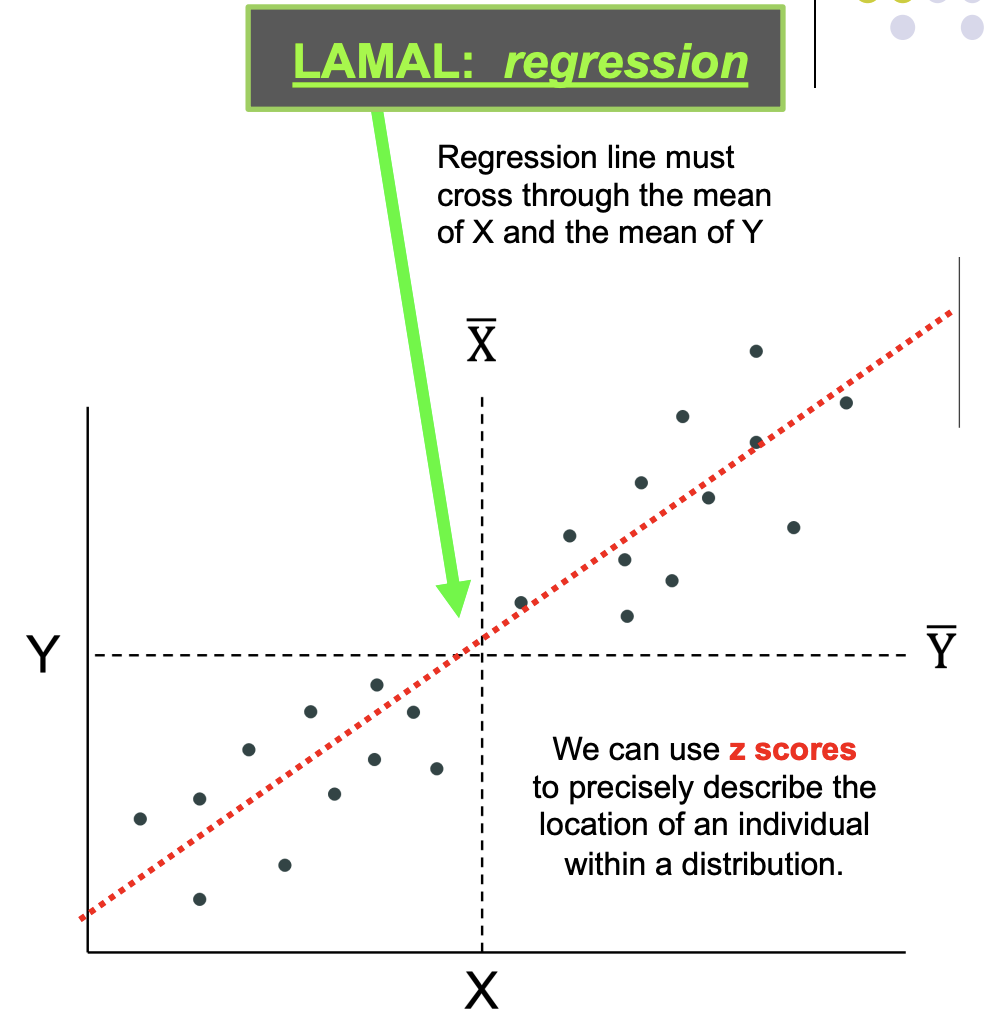
Definitional formula for r
SSxy = SP = Sum of Products: How much X and Y covary
Remember: SS = how much a set of scores varies from its mean.
So we will use… SSX for variable X SSY for variable Y.
r assesses how the covariation of X and Y relates to the variation (variability) of X and Y separately
Unlike sum of squares, covariance CAN be negative! (i.e., as X increases, Y decreases).
When the covariation (numerator) is big, r is big.
Understanding r / r vs. slope
Value of r = .72→ A 1 unit increase in X is associated with, on average, a .72 unit increase in Y.
r and the slope of a line (b) are similar, but not the same.
r is in standard deviation units, whereas the slope of a line (b) is the rise over run (e.g., the change in X over the change in Y), and is in scale units.
Inferential Aspects of Correlation (i.e., “Is r significant?”)
BUT… we can get a big r in our sample even when there’s no relationship between X and Y in the population… BECAUSE… a large r could occur as a result of sampling error alone. So we need to check whether or not our r is statistically significant.
Statistics vs. Parameters
For a sample: correlation = r
For a population: correlation = ρ (rho)
Steps in Hypothesis Testing; Null & Alternative Hypotheses
H0: ρ = 0 (there is NO linear relationship in the population) H1: ρ ≠ 0 (there IS a linear relationship in the population)
Steps in Hypothesis Testing: Constructing a Sampling Distribution
Pull all possible random samples of size N (where a sample is a set of X,Y scores) from a single population, calculate the r values, and plot the r values in a histogram.
What are df?
What are df for a correlation?
We lose a df for each mean we estimate (i.e., one for X and one for Y)
So, df = N – 2
Our 3 Qs:
Is there a relationship?
Is the correlation significant? (no leading 0s!)
If so, what is the nature of that relationship?
Is the correlation positive or negative?
Describe in words using the context of the example, i.e. Disgust and conservatism were positively correlated; in other words, stronger feelings of disgust were associated with greater political conservatism
If so, what is the strength of that relationship?
Strength of the Relationship between X & Y
We can’t just use the magnitude of the correlation coefficient (r) as a measure of strength.
the same r can be big in one context and small in another, depending on N
r isn’t linear (.8 isn’t twice as big as .4)
Strength = Coefficient of determination = r²
For our example, r² = (.721)² = .52
Because it is expressed as a proportion of variability, r² can be compared across studies
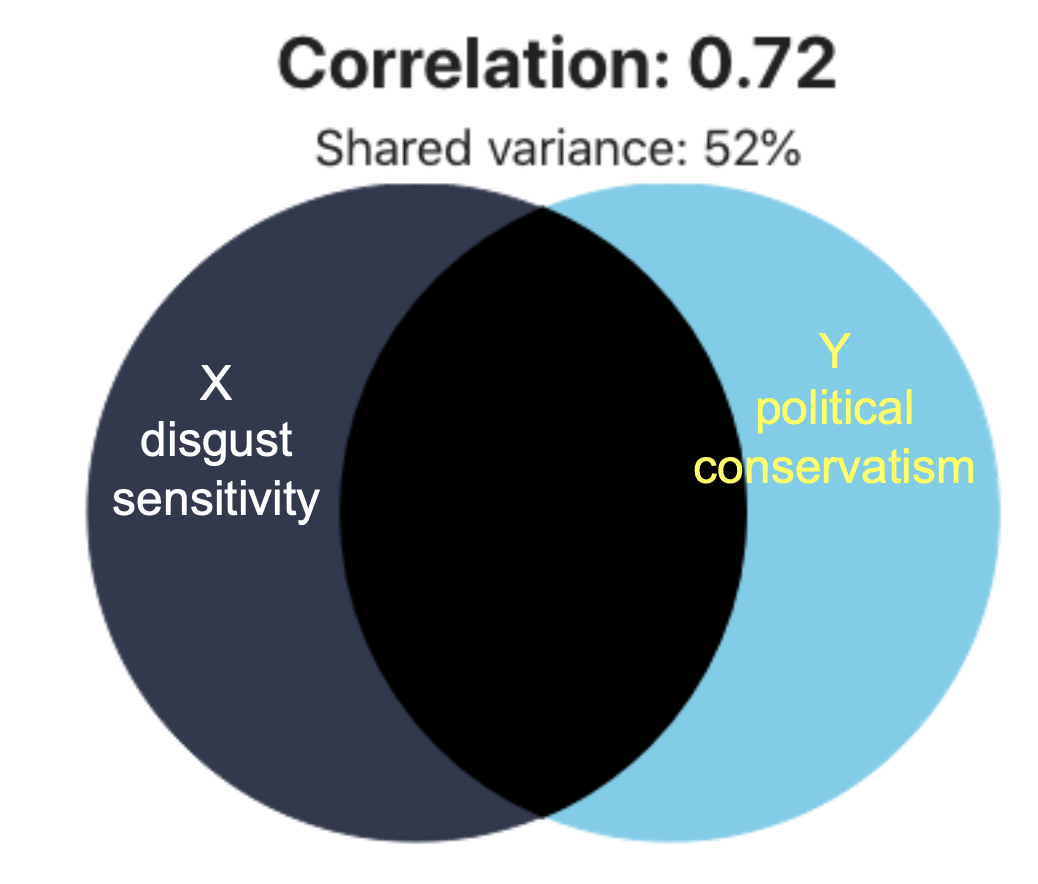
Coefficient of alienation
1 - r²; 1 - .52 = .48
proportion of variability in Y NOT explained by X; i.e., error
Assumptions of the Pearson Correlation
Sample is independently and randomly selected from the population
Bivariate normality:
The distribution of Y scores at any value of X is normal in the population
Robust to violations of this assumption if N > 15
Homoscedasticity:
Y scores have equal variances at each value of X in the population
Not robust to violations of this assumption
Data H→ They have a similar spread in Y across the range of X values.
No→ data violate the homoscedasticity assumption: They have a greater spread in Y at higher levels of X.

Bivariate Normality
Schematic of a bivariate normal dataset→ Picture this as a 3D graph, with the distributions coming out toward you.
An actual bivariate normal data set
Most of the scores fall close to the line of best fit.
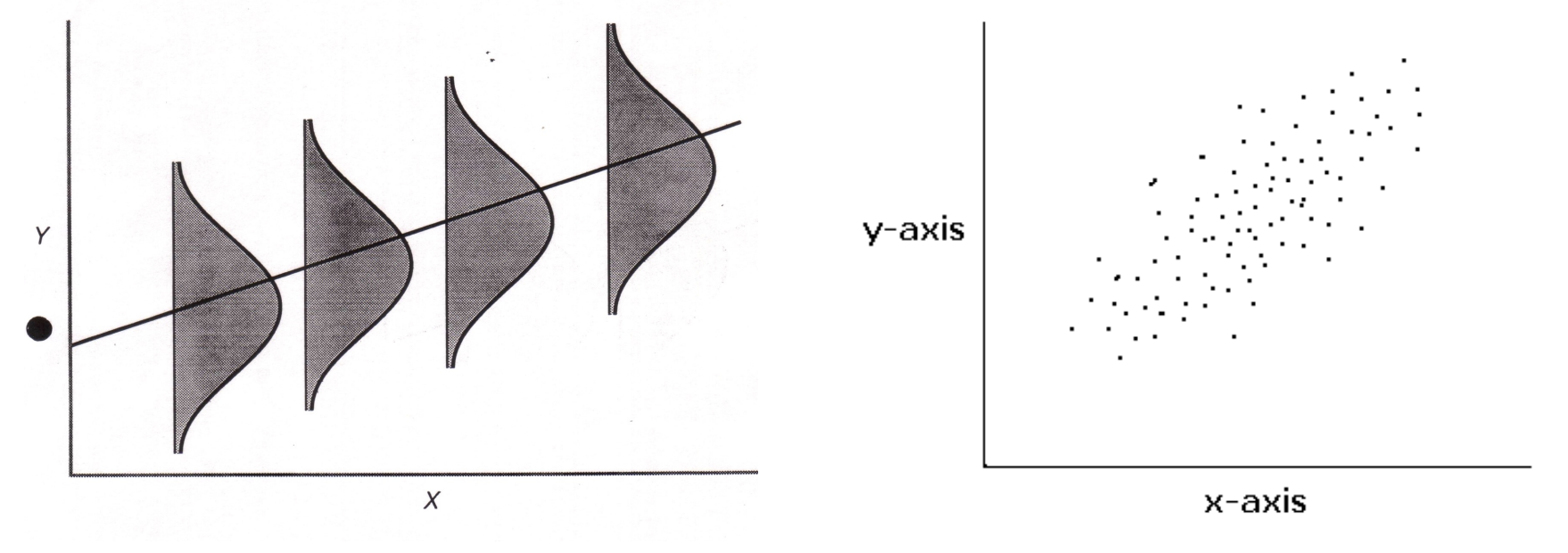
Visualizing Correlations
Notice that as r approaches 1, the data are closer and closer to the regression line.
Also consider: When r = -1 there is a perfect negative correlation between x and y
and: when r = 0 there is no correlation between x and y
…and here is what a scatterplot with a negative r looks like.
Interpreting r & r²
r = .3, r² = .09— We can explain about 9% of the variability in depression with loneliness
Problems to Watch Out For: Restricted range
Occurs when experimenters look at only one portion of the data (not good)
Can lead to underestimation of a relationship between X and Y
Can lead to overestimation of a relationship between X and Y
Restricted range: Case 1: Underestimation of Association
Strong linear relationship when full range of x values is used, but no relationship when restricted range used

Restricted range: Case 2: Underestimation of Association
Strong linear relationship when full range of x values is used, but no relationship when restricted range used
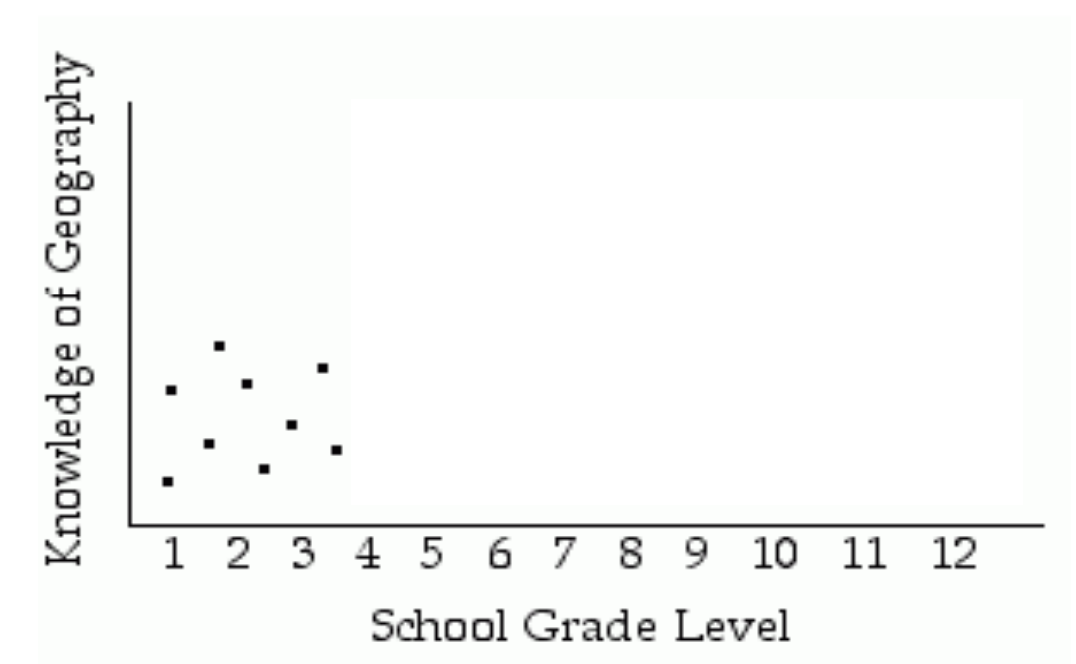
Restricted range: Case 3: Overestimation of Association
No relationship when full range of x values is used, but strong relationship when restricted range used
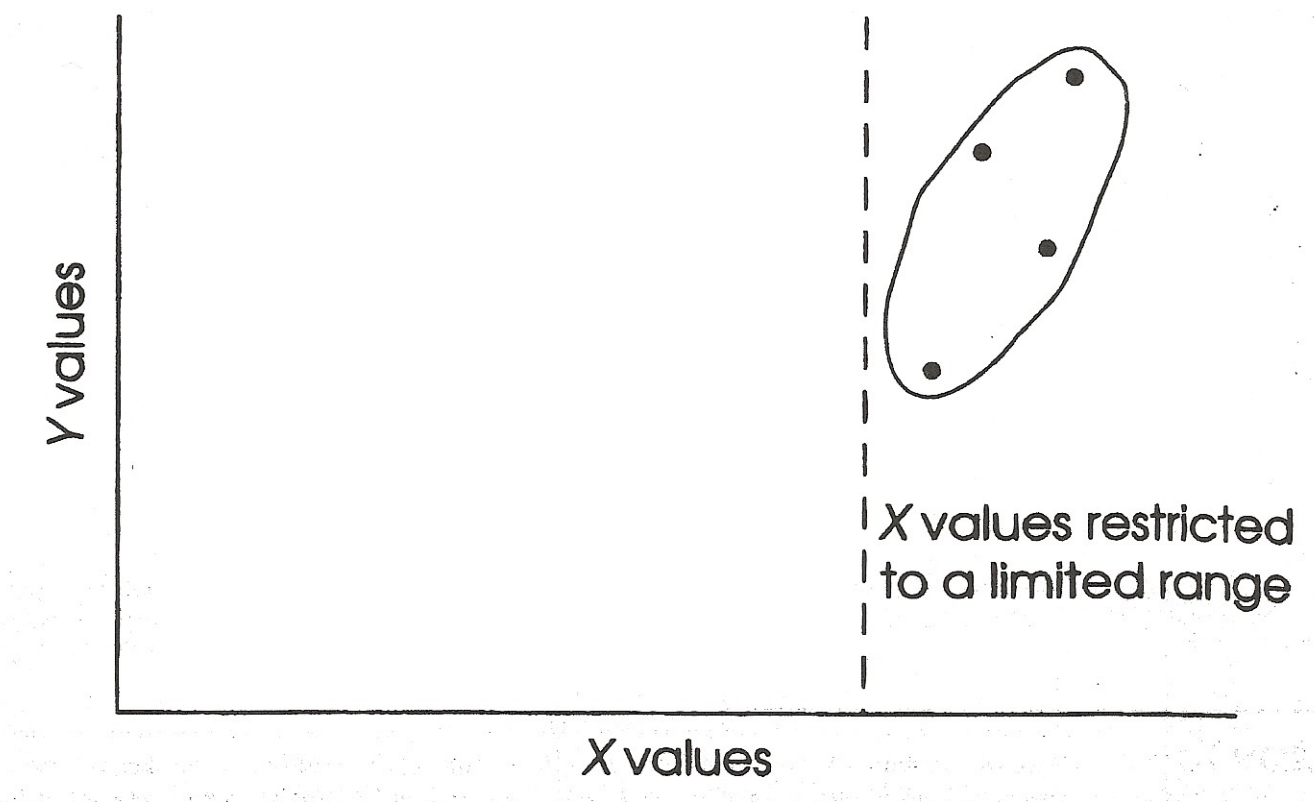
Non-linear relationships: Example 1: curvilinear relationship
Point 1: If we looked only at low to moderate levels of anxiety, we would come to an erroneous conclusion about the relationship between anxiety and performance.
To be safe, use a wide range of X and Y values, and do not make conclusions based on extrapolation beyond your observed values of X.
SIDE NOTE: I will ask you to extrapolate when you calculate the regression line, though.
Point 2: These x and y data are not linear. Don’t conduct a correlation analysis on these data!
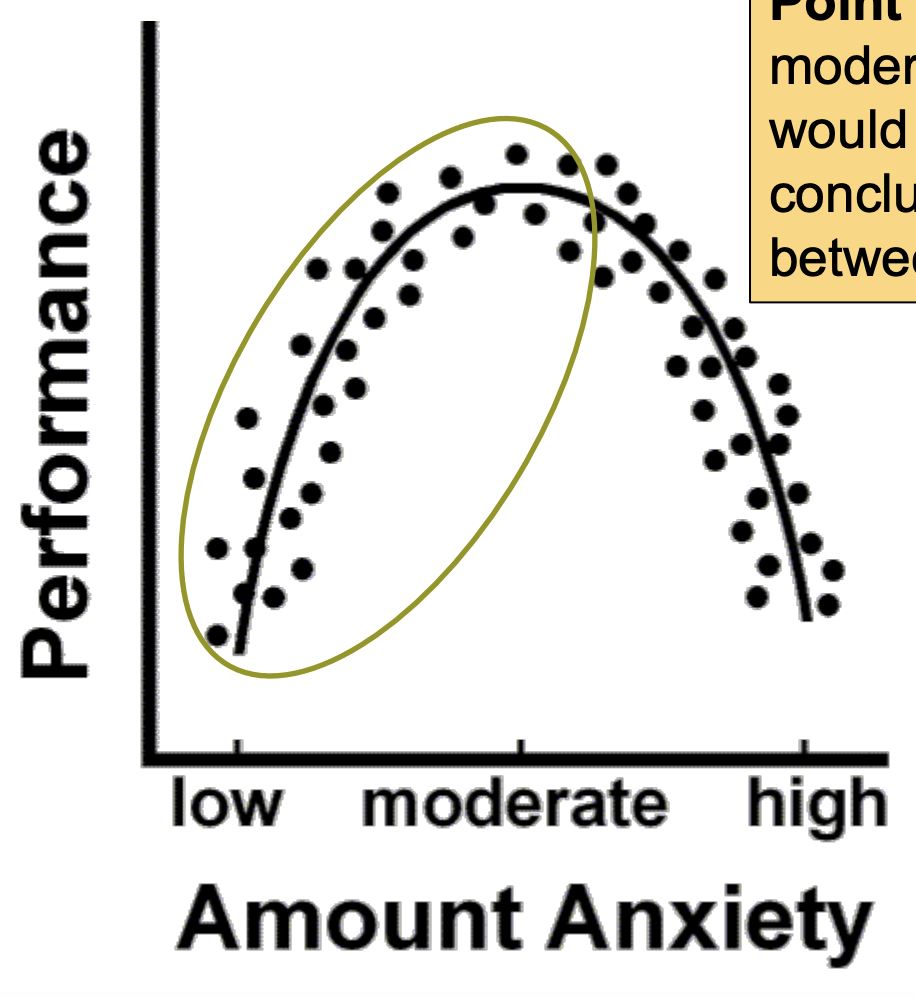
Non-linear relationships: Example 2
These data are not linear (the curve levels off – is asymptotic)
Here, the change in the y-values become increasingly small as the x-values increase.
Don’t conduct a correlation analysis on these data!

Problems to watch out for continued: Outliers
Scores that are outside the range for X, Y, or both
Can cause either over or underestimation of the correlation
Outliers: Overestimation of association
Including the outlier (inaccurately) strengthens the correlation.
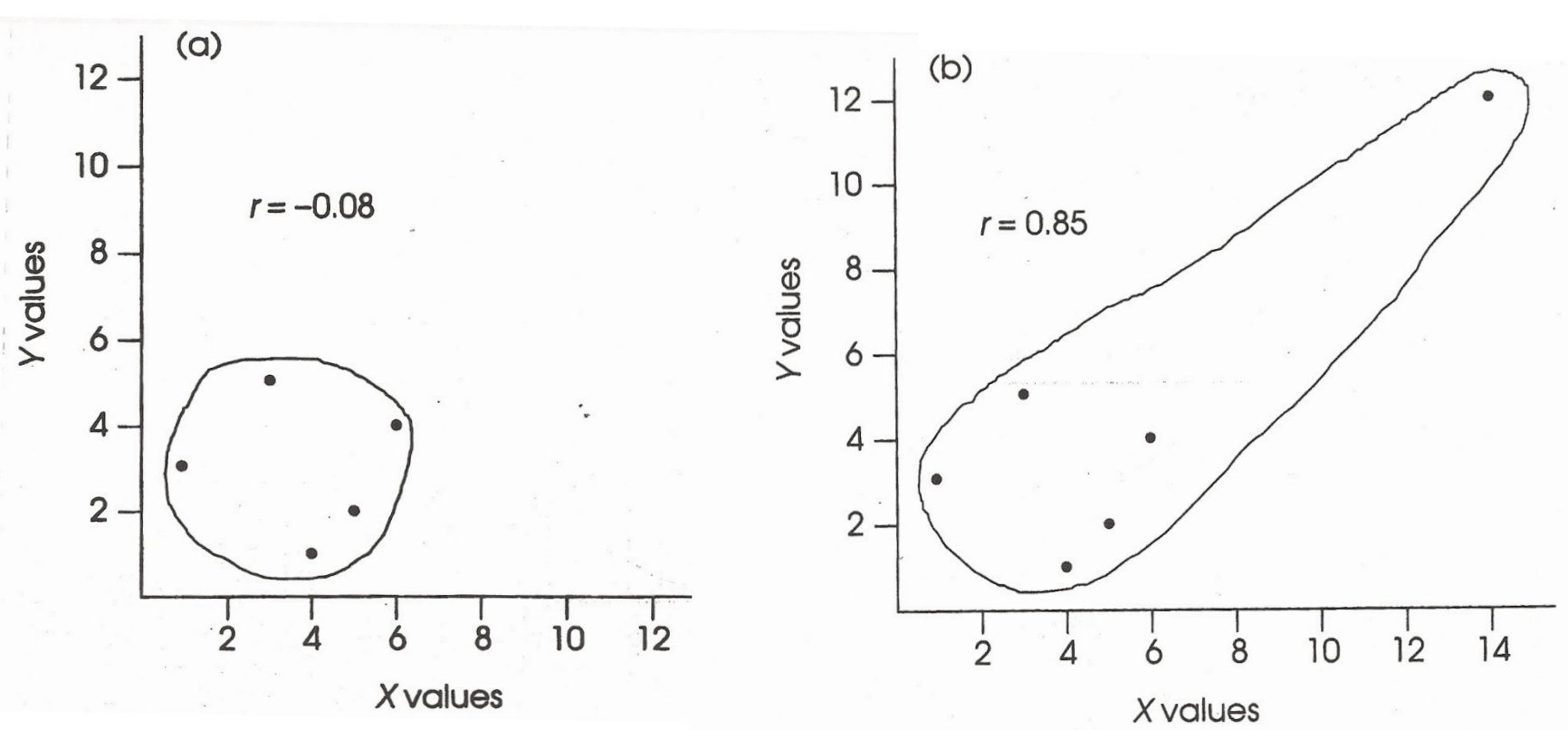
Outliers: Underestimation of association
In this case, including the outlier weakens the correlation.
Bottom line:
Always look at a scatterplot of your x and y data!
Set your criteria for outlier removal BEFORE plotting or analyzing the data. Do not tempt yourself into selective data trimming!

The Pearson Product-Moment Correlation (r) - Conceptual Understanding
r is an indicator of location in X distribution (relative to mean of X)
and location in Y distribution (relative to mean of Y)
Regression: line must cross through the mean of X and the mean of Y
We can use z scores to precisely describe the location of an individual within a distribution.
So, for a positive correlation: positive Z scores on X correspond to positive Z scores on Y;
negative Z scores on X correspond to negative Z scores on Y.
For a negative correlation, positive Z scores on X correspond to negative Z scores on Y and vice-versa.
Statistics vs. Parameters
For a sample: correlation = r
For a population: correlation = p (rho)
What are the null & alternative hypotheses for a test of correlation?
H0: p = 0 (there is NO linear relationship in the population) H1: p ≠ 0 (there IS a linear relationship in the population)
Flashback: How did we construct the sampling distribution for the paired sample t test?
Pull all possible random samples of size N from a single population (where a sample is a set of difference scores), calculate the means, and plot the means in a histogram.
How do we construct the sampling distribution of r?
Pull all possible random samples of size N (where a sample is a set of X,Y scores) from a single population, calculate the r values, and plot the r values in a histogram.
3 Qs for every test:
Is there a relationship? (i.e., is the correlation significant?)
If so, what is the nature of that relationship?
Is the correlation positive or negative? (r = .72)
Describe in words using the context of the example:
Disgust and conservatism were positively correlated; in other words, stronger feelings of disgust were associated with greater political conservatism
If so, what is the strength of that relationship?
Strength of the Relationship Between X and Y
We can’t just use the magnitude of the correlation coefficient (r) as a measure of strength.
the same r can be big in one context and small in another, depending on N
r isn’t linear (.8 isn’t twice as big as .4)
Strength = Coefficient of determination = r2
For our example, r2 = (.721)² = .52 (no leading 0)
shared variance; 52% of the variability (SS) in political conservatism can be explained/predicted by disgust sensitivity (like h2!)
Because it is expressed as a proportion of variability, r² can be compared across studies.
Coefficient of alienation
1 - r²; proportion of variability in Y NOT explained by X; i.e., error
Assumptions of the Pearson Correlation
Sample is independently and randomly selected from the population
Bivariate normality:
The distribution of Y scores at any value of X is normal in the population
Robust to violations of this assumption if N > 15
Homoscedasticity
Y scores have equal variances at each value of X in the population
Not robust to violations of this assumption
Visualization of Homoscendasticity
1st— data are homoscendastic: they have a similar spread in Y across the range of X values
2nd— These data violate the homoscedasticity assumption: They have a greater spread in Y at higher levels of X.
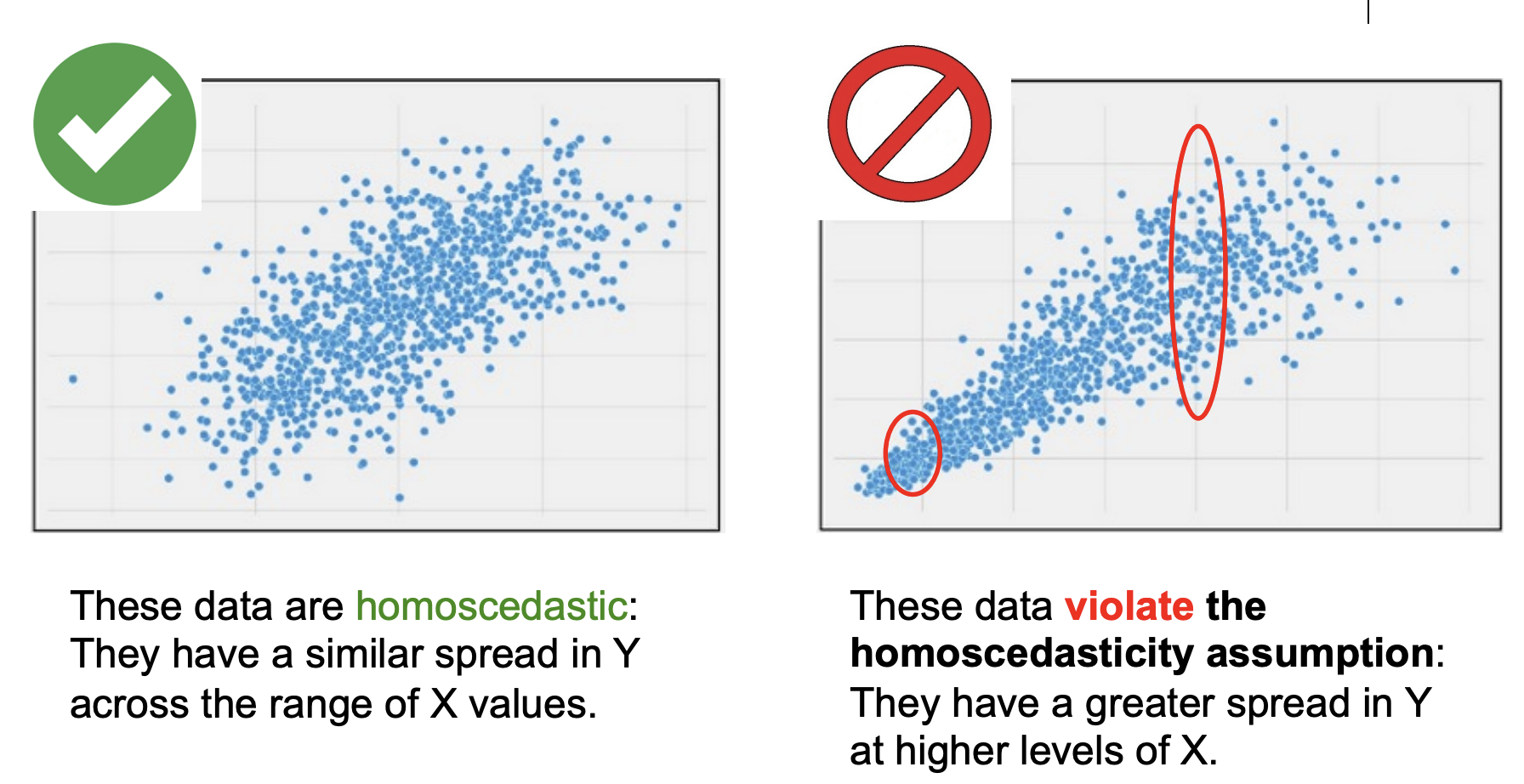
What you need to conduct a regression analysis
You need the disgust scores (X = predictor variable)
X and Y need to be significantly correlated (r = sig).
You need the formula for the regression line
You need to do some simple math
THM: Regression allows you to be a bit more accurate than just relying on the mean of Y to predict the individual scores of Y.
Least-squares line
If you know someone’s disgust sensitivity score, and you have a least-squares regression line, you can predict any y value based on a given x value
Why is it called this?
Because it minimizes the squared vertical distances of the points to the line. — Should do a better job of predicting Y than just using the mean of Y
Regression involves finding the formula for the line that best predicts Y from X
Regression line vs. basic formula
Y = a + bX (where a = y intercept, b = slope)
vs
Ŷ = a+bX
The equation yields a predicted Y value for every X value rather than an actual Y value.
The line is a prediction, so the points don’t all fall exactly on the line; there will be error associated with the line.
b vs. r
b→ Describes the relation between X & Y in X & Y units
r→ Describes the relation between X & Y in standardized units (Z scores). An r of .72 means that a 1 SD change in X is associated with, on average, a .72 SD change in Y.
If you transform X & Y to Z scores before correlating them, r = b.
Formula for the y-intercept
We know that the regression line must go through the mean of the X ratings (IV; = 2.083) and the mean of Y ratings (DV; = 4.500)
So we can plug in the means for X and Y into our formula to calculate the Y intercept:
Plotting the least-squares line
Step 1. Select the lowest (0) & the highest (4) values of X.
Step 2. Plug in 0 for X to get the first Y value.
Step 3. Plug in 4 for X to get the second Y value.
Other than to calculate the Y intercept, do not extend your line past the values of X! Can’t extrapolate!
Accuracy of the Regression Line
What is the relationship between r and the accuracy of the regression equation?
The bigger the r, the closer the points are to the line and the more accurate the regression equation
How do we evaluate how good our line is?
Compute the standard error of estimate, which tells us, on average, how far the points fall (vertically) from the regression line